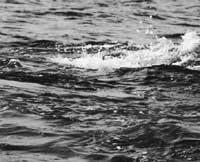Mysteries of the water
1994/06/01 Elhuyar Zientzia Iturria: Elhuyar aldizkaria
According to a group of scientists from Italy and Britain, there are still points not diluted by microscopic forces that govern the water structure. In the British laboratory Rutherford Appleton an x-ray of water by diffraction of neutrons has been performed. Water has been used in supercritical conditions (that is, when there is no distinction between liquid state or steam) and the objective has been to know if they are able to explain the characteristics of the current water model at temperatures between 300 and 400 °C.

The diffraction of neutrons allows to visualize the distance to which are the atoms of hydrogen and oxygen. Under supercritical conditions, as at room temperature, the structure of the H2O molecule practically does not change and the distances between O-H and H-H are respectively 1 and 1.55 angstromgos.
The position of the molecules changes each other. At room temperature, the main feature is the chemical relationship between oxygen and a hydrogen of two consecutive molecules. The so-called “hydrogen bond” keeps both atoms at a distance of 1.9 angstromas. However, when the temperature ranges between 300-400 °C, the diffraction of neutrons indicates that this distance changes, although the thermal agitation of the molecules is not enough to break that “hydrogen bond”.
Normally, water-related models do not serve to determine interatomic distances based on temperature. Therefore, it is true that the water that has created and developed life is a strange fluid from many aspects.

Gai honi buruzko eduki gehiago
Elhuyarrek garatutako teknologia


